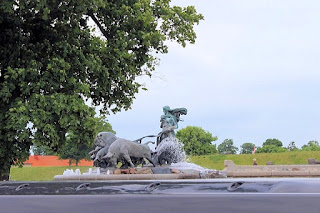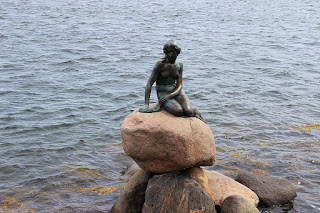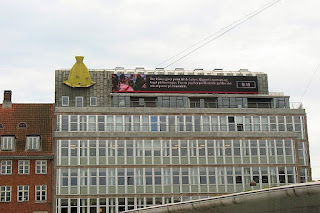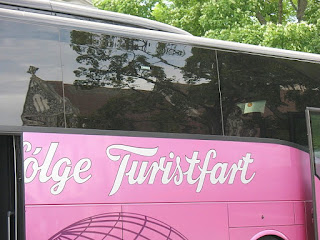 Toward the end of our day in Helsingor, the sky’s completely cleared and for the first time since leaving Arizona, we enjoyed our first sunny afternoon – though the temps were only in the low 60’s. Our short sail to Copenhagen was beautiful, the open decks were packed, and everyone was having a great time.
Toward the end of our day in Helsingor, the sky’s completely cleared and for the first time since leaving Arizona, we enjoyed our first sunny afternoon – though the temps were only in the low 60’s. Our short sail to Copenhagen was beautiful, the open decks were packed, and everyone was having a great time.
Copenhagen is the capital and largest city in Denmark, with a population of roughly 765,000. The larger urban area has a population just north of 1.2M, so combined, the metro area is over 2 million. This is definitely the most modern, upscale city we’ve visited thus far. Since the turn of the 21st century, Copenhagen has seen strong urban and cultural development, facilitated by investment in its institutions and infrastructure. The city is the cultural, economic and governmental center of Denmark…& it’s one of the major financial centers of Northern Europe with the Copenhagen Stock Exchange. The economy has seen rapid developments in the service sector, especially through initiatives in information technology, pharmaceuticals and clean technology. With a number of bridges connecting the various districts, the cityscape is characterized by parks, promenades and waterfronts. It reminds us of Amsterdam with its numerous canals. It has many landmarks such as Tivoli Gardens, The Little Mermaid statue, the Amalienborg and Christiansborg palaces, Rosenborg Castle Gardens, Frederik's Church, and many museums. And of course, there are many restaurants and nightclubs, though we didn’t eat or drink off the ship, and rarely do. You never know what you might get into, even in this beautiful city. Plus, why spend money ashore on food when it’s ‘free’ on the ship? I can understand why some folks want a taste of the local cuisine and respect that, but more often than not, Holland America typically creates their menus to reflect a particular geographic area, and their chefs are truly exceptional.
We were docked by 6pm, and many folks opted to take a night tour to Tivoli Gardens. It’s a beautiful place, but we decided to wait until daylight. Why take photos of plants and flowers at night…particularly since the sun doesn’t set until almost 11pm this time of year? Plus, local busses weren’t running and the cab fare was pretty steep. Each to his own. Instead, we went to happy hour in the Oceans Bar, listened to the band for a while, had dinner in the Lido, and turned in about 10:00.
A 2-day stay really enables you to explore the city more thoroughly. Copenhagen is home to the University of Copenhagen, the Technical University of Denmark and Copenhagen Business School. The University of Copenhagen, founded way back in the 1400’s, is the oldest university in Denmark and we’re told it currently has 35,000 students. And the bicycles! We thought Amsterdam had bicycles! They say it’s one of the most bicycle-friendly cities in the world, and we can understand why! They even have bike-only bridges.
Shortly after the end of the war and in 1947, an innovative urban development project known as the Finger Plan was introduced, encouraging the creation of new housing and businesses interspersed with large green areas along five "fingers" stretching out from the city center. With the expansion of the welfare state and women entering the work force, schools, nurseries, sports facilities and hospitals were established across the city. As a result of student unrest in the late 1960s, the former Badsmandsstraede Barracks in Christianshavn was occupied, leading to the establishment of Freetown Christiania in 1971.
On the cultural front, the lavish Copenhagen Opera House, a gift to the city from the shipping magnate Maersk, was completed in 2004. Whenever you see those massive freighter ships, chances are you’ll see several of them with the Maersk name on some if not a large majority of containers. While the opera house is large and very nice, it pales in comparison to Sydney’s, but then nothing can even come close to that structure.
Oh, and before I forget, in December 2009 Copenhagen gained international prominence when it hosted the worldwide climate meeting – we were able to visit the meeting hall.
The city center itself lies in the area originally defined by the old ramparts, which are still referred to as the Fortification Ring and kept as a partial green band around it. They consist mainly of residential housing and apartments often enhanced with parks and greenery. The central area of the city consists of relatively low-lying flat ground formed by moraines, while the hilly areas to the north and west frequently rise to about 160 feet above sea level. The slopes of Valby & Bronshoj reach heights of over 100 feet, divided by valleys running from the northeast to the southwest. Also, close to the center are the three beautiful lakes, but I didn’t catch their names.
They tell us that Copenhagen is in the oceanic climate zone, with its weather subject to low-pressure systems from the Atlantic…resulting in unstable conditions throughout the year. We also learned that June is the sunniest month of the year with an average of about eight hours of sunshine a day. July is the warmest month and can reach temps as high as 90 degrees. Well, it’s almost July, and we haven’t seen anything close to that!
Because of Copenhagen's northern latitude, the number of daylight hours varies considerably between summer and winter. On the summer solstice, you have roughly 17 hours of daylight. On the winter solstice, about 7 hours of daylight.
Copenhagen is recognized as one of the most environmentally friendly cities in the world, and it’s easy to understand why. As a result of its commitment to high environmental standards, the city has been praised for its green economy, ranked as the top green city for the second time in the 2014 Global Green Economy Index. In 2001 a large offshore wind farm was built just off the coast of Copenhagen at Middelgrunden. We were able to view it during our late afternoon sail-in. It produces about 4% of the city's energy. Their goal here is to be carbon-neutral by 2025. On the downside of that and in their effort to keep autos at a minimum, the tax on a new car is 180%. So, let’s say you buy a vehicle for $10K…the tax is an additional $18K – so total out-of-pocket is $28K. That would certainly encourage me to ride a bike! Years of substantial investment in sewage treatment have improved water quality in the harbor to an extent that the inner harbor can be used for swimming with facilities at a number of locations, though there’s no way in hell we’re testing it!
For a number of years, Copenhagen has ranked high in international surveys for its quality of life. Its stable economy together with its education services and level of social safety make it attractive for locals and visitors alike. Although it is one of the world's most expensive cities, it is also one of the most livable with its public transport, facilities for cyclists and its environmental policies.
Sometimes referred to as "the City of Spires", Copenhagen is known for its horizontal skyline, broken only by the spires and towers of its churches and castles. Most characteristic of all is the Baroque spire of the Church of Our Savior with its narrowing external spiral stairway. We were able to get several pictures of that. However, the boom in urban development and modern architecture has brought some changes to the city's skyline. A political majority has decided to keep the historical center free of high-rise buildings, but several areas will see or have already seen massive urban development. Orestad now has seen most of the recent development. Located near Copenhagen Airport, it currently boasts one of the largest malls in Scandinavia and a variety of office and residential buildings as well as the IT University and a high school.
As with any large city, you have an element of crime and Copenhagen is no different. We were warned about pickpockets and sure enough, we were witness to an assault in a park not far from the ship. A group of Japanese tourists were taking photos and a local thug grabbed a purse. After she screamed and it became apparent that the guy running through the park was the perpetrator, several Japanese men took off in pursuit – the thug dropped the purse, and the large crowd applauded. Thankfully no one was hurt and the purse was recovered.
Not far from our ship & just north of the city center, Osterbro is an upper middle-class district with a number of fine mansions, some now serving as embassies. The district stretches from Norrebro to the waterfront where The Little Mermaid statue can be seen from the promenade known as Langelinie. Cheryl was able to get a quick photo though the area was packed with tourists. Inspired by Hans Christian Andersen's fairy tale, it was created by Edvard Eriksen and unveiled in 1913. Not far from the Little Mermaid, the old Citadel (Kastellet) can be seen. Built by Christian IV, it is one of northern Europe's best preserved fortifications. The large Gefion Fountain designed by Anders Bundgaard and completed in 1908 stands close to the southeast corner of Kastellet. Its figures illustrate a Nordic legend. You’ll see several photos of the fountain and in fact, that’s where the pickpocket was hanging out as described earlier.
The Tivoli Gardens, as mentioned early on, is an amusement park and pleasure garden located in central Copenhagen between the City Hall Square and the Central Station. It opened way back in 1843, making it the second oldest amusement park in the world. I’m not sure what or where the oldest is. Among its rides are the oldest still operating rollercoaster Rutschebanen from 1915 and the oldest Ferris wheel still in use, opened in 1943. No…we rode neither one! The Gardens also serves as a venue for various performing arts and as an active part of the cultural scene in Copenhagen. We very much enjoyed our time there.
This is part 1 of 2.







































































































































































































